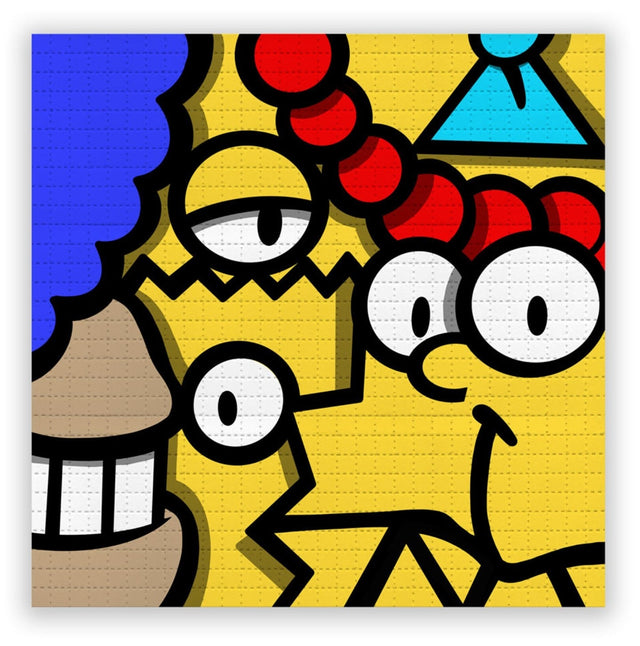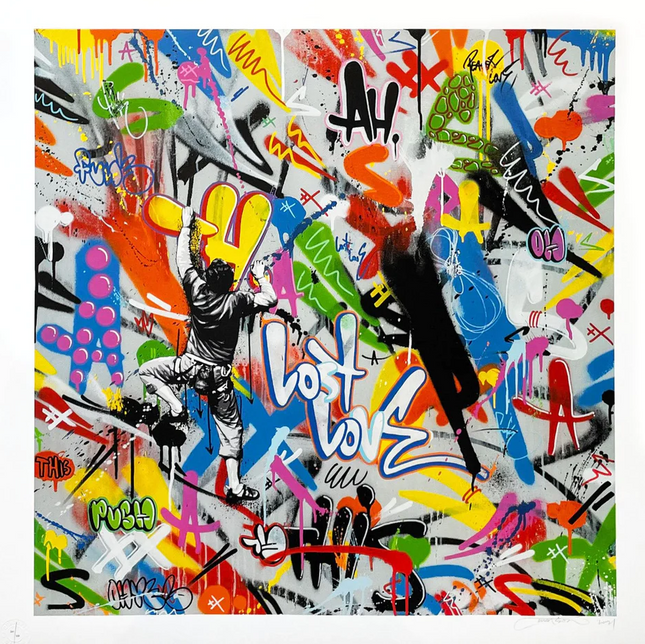
Yellow
-

Fin DAC Haiconca Metallic Yellow Gold Silkscreen Print by Fin DAC
Haiconca Metallic Yellow Gold Silkscreen Print by Fin DAC Hand-Pulled 8-Color on Full Bleed Hand Deckled 410gsm Somerset Fine Art Paper Limited Edition Findac Artwork. 2023 Signed & Numbered Limited Edition of 40 Artwork Size 20x31.5 Silkscreen Print Haiconca Metallic Yellow Gold Silkscreen Print by Fin DAC Haiconca Metallic Yellow Gold is a 2023 silkscreen masterpiece by renowned street pop art artist Fin DAC. Printed on full bleed, hand-deckled 410gsm Somerset fine art paper, this work measures 20 by 31.5 inches and comes from a strictly limited edition of only 40 signed and numbered prints. The print is created using an intricate 8-color silkscreen process, featuring a finely rendered monochromatic portrait that is electrified by a bold, metallic yellow gold mask motif. This juxtaposition of grayscale hyperrealism with vibrant symbolic color is a hallmark of Fin DAC's visual language and contributes to his ongoing commentary on cultural beauty and feminine power. Signature Style and Cultural Emblems of Fin DAC Fin DAC, born in Ireland and now internationally recognized, has redefined female portraiture in street pop art and graffiti artwork through his consistent and deliberate visual symbolism. His signature aesthetic includes masked women adorned with color-splashed facial motifs that recall traditional Asian, South American, or tribal ceremonial elements. Haiconca Metallic Yellow Gold exemplifies this ongoing thematic approach. The woman in this piece gazes directly at the viewer, poised yet guarded, her piercing eyes offset by the dripping gold mask over her upper face. Her nose ring, textured ring, and painted fingernails add to the layered storytelling that often defines Fin DAC’s subjects—powerful yet introspective, adorned yet undiminished. Process, Materials, and Artistic Execution The use of 410gsm Somerset paper is a deliberate choice, enhancing the tactile depth of the work and allowing the metallic pigment to reflect light in varying tones depending on the viewer's angle. The 8-color hand-pulled silkscreen method allows for extreme control and layering, resulting in a print that feels almost photographic while retaining its raw street art origin. The hand-deckled edges give the print a raw, sculptural quality that complements the street-to-gallery ethos central to Fin DAC's practice. These production details are not incidental—they are essential to understanding how street pop art has evolved into a serious collectible fine art medium. Contemporary Relevance in Street Pop Art & Graffiti Artwork Haiconca Metallic Yellow Gold stands as a visually arresting reflection on identity, agency, and perception. The metallic yellow mask is both shield and declaration—a visual metaphor for the roles women adopt or resist in contemporary society. Fin DAC’s work continues to elevate women of diverse cultural backgrounds not as exotic symbols, but as empowered individuals commanding their presence across urban and gallery landscapes. In the context of street pop art and graffiti artwork, this piece bridges photorealistic portraiture with bold iconography, highlighting Fin DAC’s place as a pivotal figure in the genre. With only 40 editions produced, this 2023 release offers collectors a rare and powerful work that speaks directly to the moment while maintaining timeless aesthetic and emotional depth.
$2,144.00
-

Martin Whatson Rock Climber PP Giclee Silkscreen Print by Martin Whatson
Rock Climber PP Giclee Silkscreen Print by Martin Whatson Printers Proof Hand-Pulled 18-Color Screen Print on 300gsm Somerset Fine Art Paper Limited Edition Pop Street Artwork & Graffiti. PP Printers Proof 2021 Signed & Marked P/P Limited Edition Run Artwork Size 31.5x31.5 Giclee Over Silkscreen Print. Martin Watson Artistic Approach "Rock Climber PP" is a giclée and silkscreen print by Martin Whatson, a notable figure in contemporary street pop art and graffiti. As a Printer's Proof (PP) from a limited edition run in 2021, this piece captures the dynamic essence of urban art. Signed and marked by the artist, "Rock Climber PP" spans 31.5 inches by 31.5 inches and showcases Whatson's adeptness in blending giclée precision with the rawness of hand-pulled screen printing. Martin Whatson's art is recognized for its vivid portrayal of motion and emotion, often juxtaposed against a monochrome background. In "Rock Climber PP," Whatson employs an 18-color screen print on 300gsm Somerset fine art paper, a medium well-regarded for its texture and durability, which is crucial for the layered technique used in the work. The artwork is distinguished by its hand-pulled screen printing method, which ensures that each color layer is applied with personal attention, contributing to the print's depth and vibrancy. Convergence of Techniques in "Rock Climber PP" The combination of giclée and silkscreen print in "Rock Climber PP" exemplifies the convergence of digital precision and traditional printmaking. Giclée prints are known for their high-resolution and sharp detail, derived from digital printing. This modern technique allows for the gradations and nuances of the original artwork to be captured with exceptional clarity. On the other hand, silkscreen printing is a manual process that involves forcing ink through a mesh screen to create an image. It's a method deeply rooted in the history of street art and pop art due to its directness and capacity for bold, saturated colors. Cultural Impact of Watson's Work "Rock Climber PP" is more than a mere amalgamation of techniques; it is a visual narrative that speaks to the urban experience and its inherent search for meaning. The figure of the rock climber, striving upward amidst the chaotic splashes of color, symbolizes the human quest for progress and the challenges faced in the climb. This imagery represents street pop art's core themes: struggle, resilience, and the beauty found in the act of creation. The Significance of Limited Edition Prints As a Printer's Proof, "Rock Climber PP" holds a special place in collectible art. The printer or artist typically retains these proofs and are not part of the numbered edition, making them rarer than the standard prints. Collectors highly prize them for their exclusivity and the insight they provide into the artist's process. In addition, Watson's signature and the PP mark on the artwork seal authenticity, further elevating the print's value and desirability. In conclusion, "Rock Climber PP" by Martin Watson stands as a vibrant embodiment of the street pop art and graffiti movement. It captures the essence of urban art through the interplay of giclée and silkscreen techniques, resulting in an intricate and explosive piece. The print is a testament to Whatson's skillful navigation of art forms and ability to convey profound messages through his distinctive visual language. This artwork resonates with the energy of the streets and the spirit of contemporary art, encapsulating the genre's vitality.
$4,376.00



